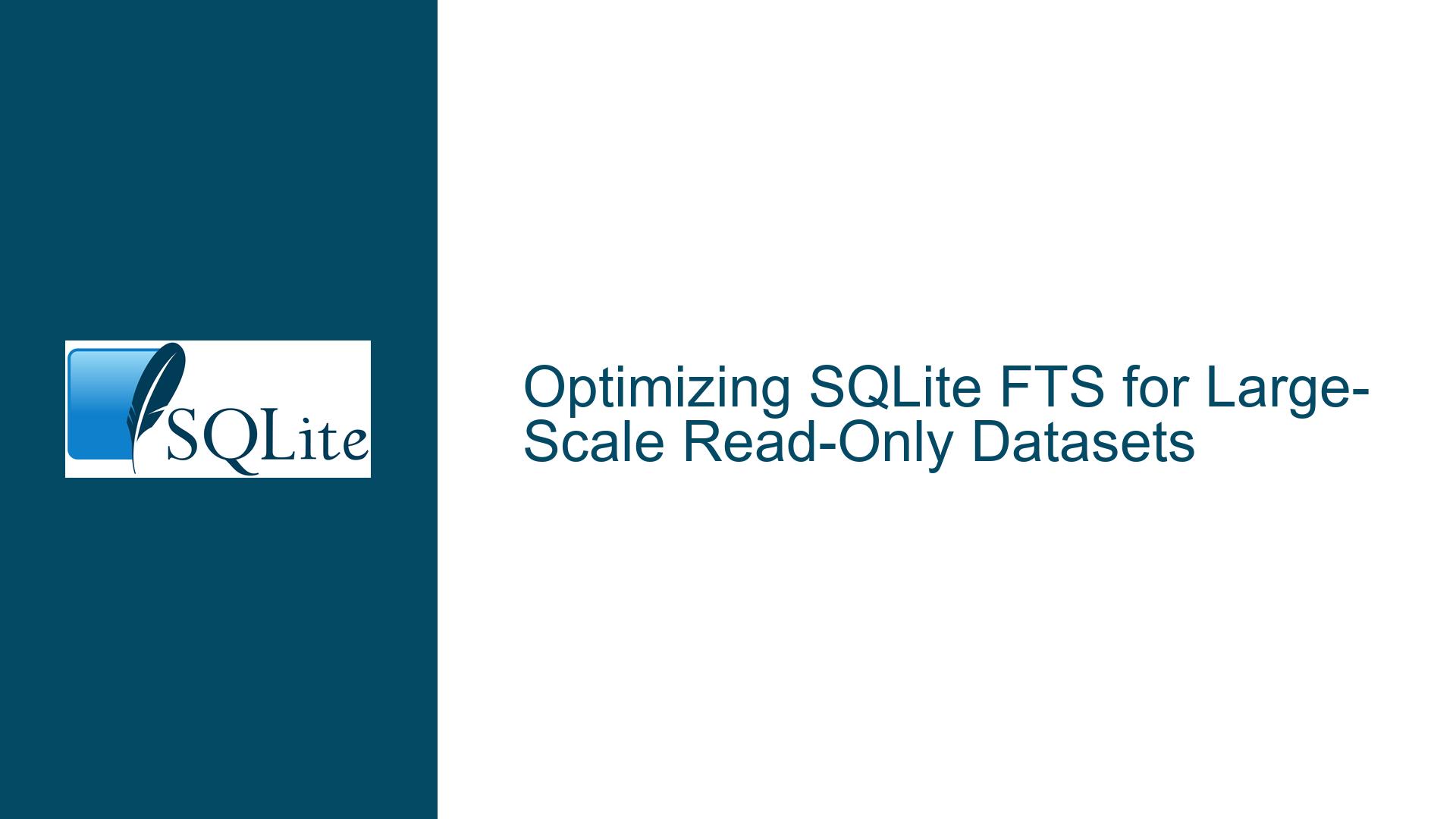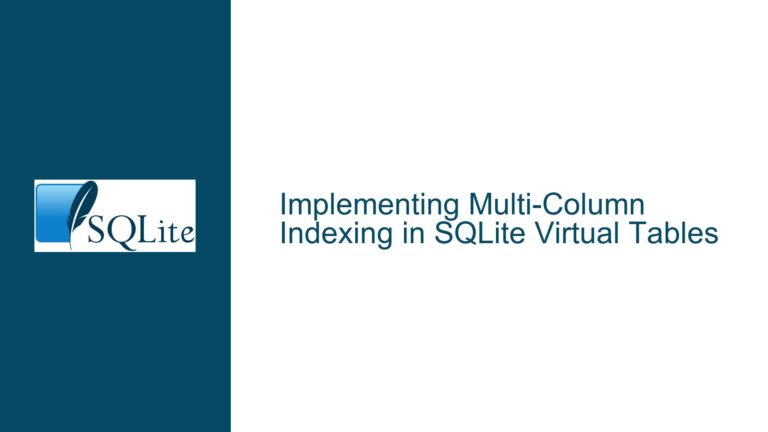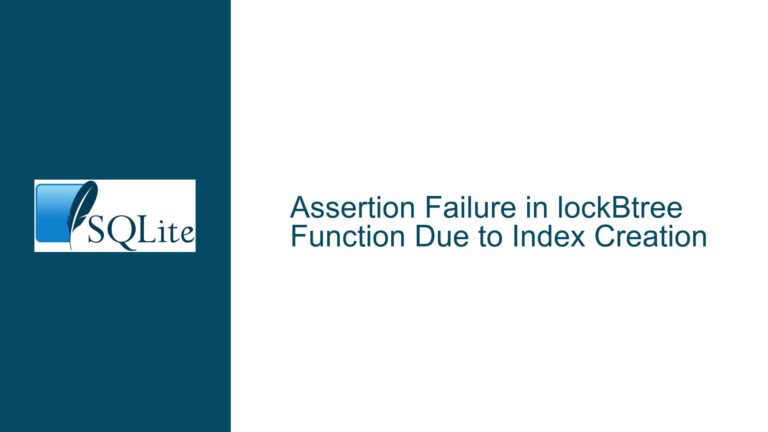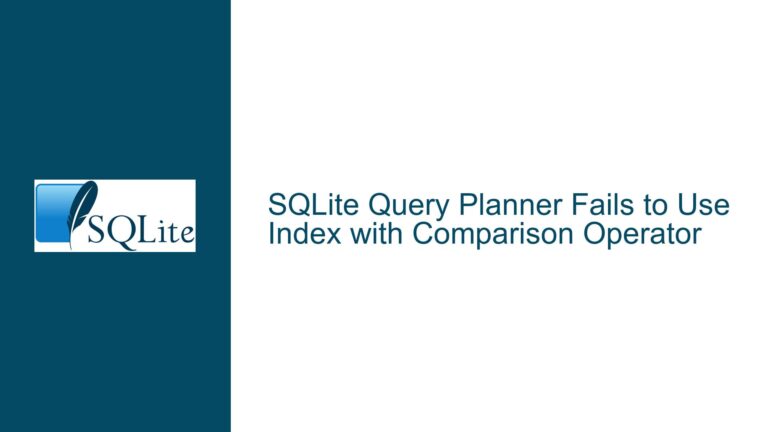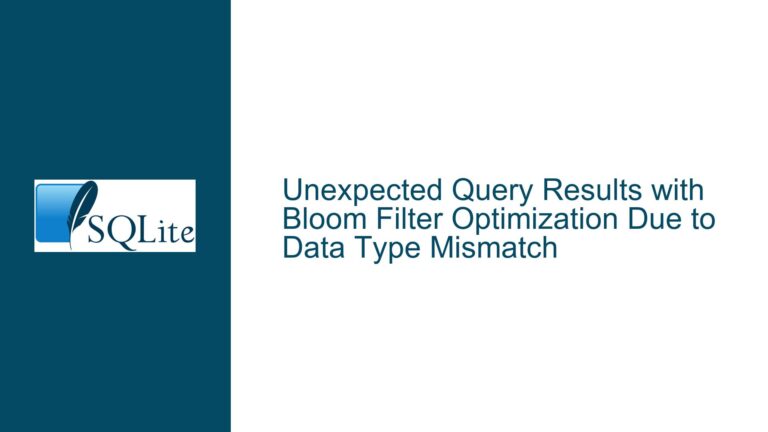Optimizing SQLite FTS for Large-Scale Read-Only Datasets
Understanding SQLite FTS Limitations in Large-Scale Read-Only Applications
SQLite’s Full-Text Search (FTS) extension is a powerful tool for enabling fast and efficient text-based queries within a database. However, when applied to large-scale, read-only datasets—such as a 43GB Wikipedia dump—certain limitations and performance considerations come to the forefront. These limitations are not necessarily flaws in SQLite itself but rather trade-offs inherent to its design, which prioritizes simplicity, portability, and lightweight operation. Understanding these limitations is crucial for developers aiming to optimize FTS for large datasets.
The primary challenge with SQLite FTS in this context is its handling of large text corpora. While SQLite is capable of managing multi-gigabyte databases, the FTS extension introduces additional complexity due to its indexing mechanisms. FTS creates inverted indexes to enable rapid text searches, but these indexes can grow significantly in size, impacting both storage requirements and query performance. Furthermore, the read-only nature of the dataset introduces unique constraints, as traditional optimization techniques like write-ahead logging (WAL) or incremental indexing are not applicable.
Another critical aspect is the trade-off between search accuracy and resource utilization. SQLite FTS supports multiple tokenizers and ranking algorithms, each with its own performance characteristics. For instance, the Porter stemming algorithm can reduce index size by normalizing words to their root forms, but this may lead to over-stemming and reduced search precision. Similarly, ranking algorithms like BM25, while effective for relevance scoring, can be computationally expensive when applied to large datasets.
The static nature of the dataset also raises questions about index maintenance. In a read-only environment, the FTS index must be built entirely during the initial database creation phase. This process can be time-consuming and resource-intensive, particularly for datasets as large as Wikipedia. Once the index is built, however, query performance can be excellent, provided the index is optimized for the specific query patterns expected in the application.
In summary, the limitations of SQLite FTS in large-scale read-only applications stem from its indexing mechanisms, tokenization strategies, and the inherent trade-offs between search accuracy and resource utilization. These factors must be carefully balanced to achieve optimal performance.
Exploring the Root Causes of FTS Performance Bottlenecks
The performance bottlenecks observed in SQLite FTS when applied to large-scale read-only datasets can be attributed to several underlying causes. These causes are interrelated and often compound each other, leading to suboptimal query performance or excessive resource consumption. By dissecting these root causes, we can better understand how to mitigate their impact.
One of the primary causes of performance bottlenecks is the size and structure of the FTS index. Inverted indexes, while efficient for text search, can become unwieldy when applied to massive datasets. Each unique term in the dataset requires an entry in the index, along with pointers to all documents containing that term. For a dataset like Wikipedia, which contains millions of articles and billions of words, this results in an index that is both large and complex. The sheer volume of data can overwhelm SQLite’s lightweight architecture, leading to slower query times and increased memory usage.
Another contributing factor is the choice of tokenizer. SQLite FTS supports several tokenizers, including simple, Porter, and Unicode-aware tokenizers. Each tokenizer has its own strengths and weaknesses, but none are universally optimal for all use cases. For example, the simple tokenizer is fast and lightweight but lacks support for advanced text processing features like stemming or stop-word removal. The Porter tokenizer, on the other hand, supports stemming but may introduce inaccuracies due to over-stemming. The Unicode tokenizer provides robust support for multilingual text but can be slower and more resource-intensive. Selecting the wrong tokenizer for a given dataset can exacerbate performance issues.
The ranking algorithm used by FTS also plays a significant role in query performance. SQLite FTS supports several ranking algorithms, including TF-IDF and BM25. While these algorithms are effective for relevance scoring, they can be computationally expensive, particularly when applied to large datasets. BM25, for instance, involves complex calculations that can slow down query execution, especially if the dataset contains many long documents or high-frequency terms.
Additionally, the read-only nature of the dataset introduces unique challenges. In a traditional database, indexes can be updated incrementally as new data is added. In a read-only environment, however, the entire index must be built upfront, which can be a time-consuming and resource-intensive process. Once the index is built, it cannot be modified, meaning any inefficiencies in the initial indexing process are effectively locked in.
Finally, hardware limitations can also contribute to performance bottlenecks. SQLite is designed to be lightweight and portable, but it is not immune to the constraints of the underlying hardware. Running FTS queries on a large dataset requires significant CPU and memory resources, and insufficient hardware can lead to slow query times or even crashes.
In summary, the root causes of FTS performance bottlenecks in large-scale read-only applications include the size and structure of the FTS index, the choice of tokenizer, the ranking algorithm, the read-only nature of the dataset, and hardware limitations. Addressing these causes requires a combination of careful planning, optimization, and resource allocation.
Strategies for Optimizing SQLite FTS in Read-Only Environments
Optimizing SQLite FTS for large-scale read-only datasets involves a combination of technical strategies and best practices. These strategies are designed to mitigate the performance bottlenecks discussed earlier and ensure that the FTS extension operates efficiently within the constraints of a read-only environment. By following these steps, developers can achieve significant improvements in query performance and resource utilization.
The first step in optimizing SQLite FTS is to carefully select the appropriate tokenizer for the dataset. As mentioned earlier, the choice of tokenizer has a significant impact on both index size and query performance. For a dataset like Wikipedia, which contains a diverse range of text and languages, the Unicode tokenizer is often the best choice. This tokenizer provides robust support for multilingual text and ensures that terms are accurately indexed. However, if the dataset is primarily in English and stemming is desired, the Porter tokenizer may be a better option. It is important to evaluate the specific requirements of the dataset and choose the tokenizer that best balances performance and accuracy.
Once the tokenizer has been selected, the next step is to optimize the FTS index. This involves carefully configuring the index to minimize its size and maximize query performance. One effective strategy is to use prefix indexing, which allows queries to match terms based on their prefixes. This can significantly reduce the size of the index while still providing fast and accurate search results. Another strategy is to use stop-word lists to exclude common terms like "the" or "and" from the index. These terms are often irrelevant to search results and excluding them can reduce index size and improve query performance.
The ranking algorithm is another critical factor in FTS optimization. While BM25 is a powerful algorithm for relevance scoring, it can be computationally expensive, particularly for large datasets. In some cases, it may be beneficial to use a simpler ranking algorithm like TF-IDF, which is less resource-intensive. Alternatively, developers can implement custom ranking algorithms tailored to the specific requirements of the dataset. This requires a deep understanding of both the dataset and the ranking algorithm, but it can yield significant performance improvements.
In a read-only environment, the initial indexing process is of paramount importance. Since the index cannot be modified once it is built, it is essential to ensure that the indexing process is as efficient as possible. This involves optimizing the database schema, using batch inserts to minimize overhead, and carefully tuning the indexing parameters. It may also be beneficial to use external tools or scripts to preprocess the data before indexing, reducing the workload on SQLite.
Hardware considerations are also important when optimizing SQLite FTS. Running FTS queries on a large dataset requires significant CPU and memory resources, so it is essential to ensure that the hardware is capable of handling the workload. This may involve upgrading the CPU, increasing the amount of RAM, or using faster storage devices like SSDs. Additionally, it is important to monitor resource usage during query execution and adjust the configuration as needed to prevent bottlenecks.
Finally, it is important to regularly test and benchmark the FTS implementation to identify potential performance issues. This involves running a variety of queries on the dataset and measuring their execution times, as well as monitoring resource usage. By identifying and addressing performance issues early, developers can ensure that the FTS implementation remains efficient and scalable.
In summary, optimizing SQLite FTS for large-scale read-only datasets involves selecting the appropriate tokenizer, optimizing the FTS index, choosing the right ranking algorithm, ensuring an efficient initial indexing process, addressing hardware limitations, and regularly testing and benchmarking the implementation. By following these strategies, developers can achieve significant improvements in query performance and resource utilization, ensuring that SQLite FTS operates efficiently in a read-only environment.
